标签:des winform style blog http io ar color os
最近在编写C/S结构应用程序时,感觉窗体的标题栏样式太死板了,标题文字不能更改大小、颜色、字体等,按钮不能隐藏等问题,在网上也查找了许多相关的资料,没有找到合适的解决方案,发现许多人也在寻求这个问题,最后我决定自己研究动手画一个标题栏出来,经过今天一天的研究与编写,终于完成全部功能,现公布一下我的设计思路。
一、去掉Form类自带的标题栏
要去掉自带的标题栏有两种方法,第一方法是直接将FormBorderStyle设为 System.Windows.Forms.FormBorderStyle.None,但设置过后,窗体无法改变大小,考虑到后期这些功能还是需要的,所以我采用了第二种方法,第二种方法是可以忽略FormBorderStyle,只需要将ControlBox设为 false,并将Text设为空即可,这种方法隐藏标题栏,若FormBorderStyle不是固定模式,则可以通过拉伸窗体边框改变大小的。
二、创建自定义窗体类
首先创建一个窗体,如下图:
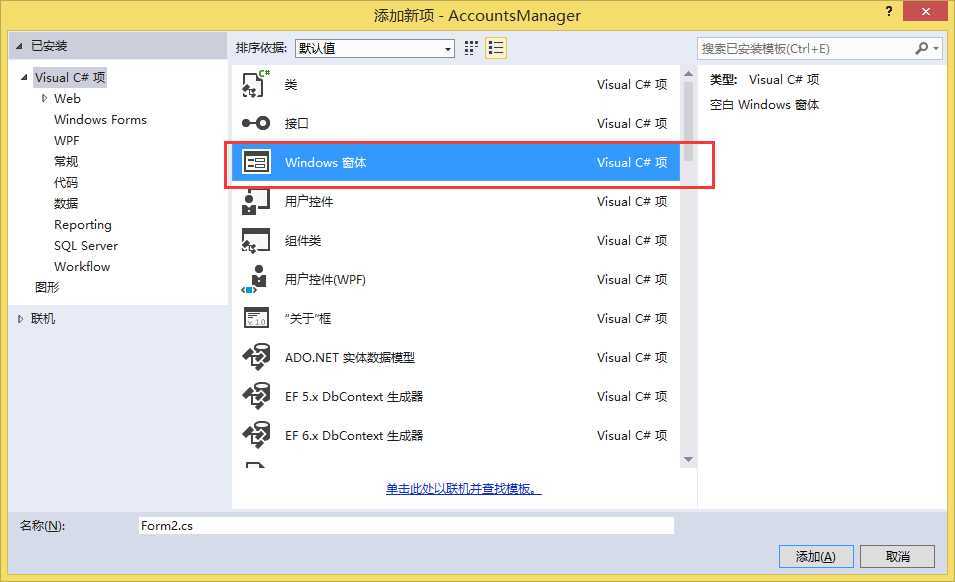
然后去掉Text默认的文字,并将ControlBox设为 false,此时标题栏将自动隐藏掉了,如下图:

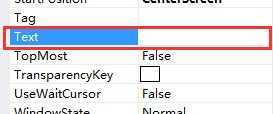
去掉标题栏后,就需要重画新的标题栏,画标题栏很简单,方法也很多,我这里是采用一个Panel,将Dock设为Top,让其项部固定,并设高度为30像素,再在其中添加三个按钮,依次为:button1(关闭),button2(最大化),button3(最小化),三个按钮的设为Size相同,且将Anchor都设为Top Right Bottom,这样就实现了让三个按钮在右边固定位置,如下图:

界面部份已经完工,剩下的就是编写代码了,由于代码较多,我先将代码贴出来,稍后再讲解。
using System; using System.Collections.Generic; using System.ComponentModel; using System.Data; using System.Drawing; using System.Linq; using System.Text; using System.Threading.Tasks; using System.Windows.Forms; namespace ZControls { /// <summary> /// Copyright Zuowenjun /// Site Url:http://www.zuowenjun.cn /// QQ:77321032 /// Description:自定义窗体样式,实现标题可自定义化 /// </summary> public partial class ZForm : Form { private bool moving = false; private Point oldMousePosition; public new FormBorderStyle FormBorderStyle { get { return base.FormBorderStyle; } set { if (value != FormBorderStyle.Sizable && value != FormBorderStyle.SizableToolWindow) { titlepanel.Controls.Remove(button2); } base.FormBorderStyle = value; } } #region 隐藏父类的属性,使其不可见 [Browsable(false)] public new string Text { get { return titlelabel.Text; } set { } } [Browsable(false)] public new bool ControlBox { get { return false; } set { base.ControlBox = false; } } #endregion [Browsable(true)] [EditorBrowsable(EditorBrowsableState.Always)] [Description("窗体标题")] public string Title { get { return titlelabel.Text; } set { titlelabel.Text = value; } } [Browsable(true)] [EditorBrowsable(EditorBrowsableState.Always)] [Description("窗体标题字体样式")] public Font TitleFont { get { return titlelabel.Font; } set { titlelabel.Font = value; } } [Browsable(true)] [EditorBrowsable(EditorBrowsableState.Always)] [Description("窗体标题字体颜色")] public Color TitleColor { get { return titlelabel.ForeColor; } set { titlelabel.ForeColor = value; } } [Browsable(true)] [EditorBrowsable(EditorBrowsableState.Always)] [Description("窗体标题栏背景色")] public Color TitleBarBackColor { get { return titlepanel.BackColor; } set { titlepanel.BackColor = value; } } public new bool MaximizeBox { get { return titlepanel.Contains(button2); } set { if (!value) { titlepanel.Controls.Remove(button2); } else if (!titlepanel.Contains(button2)) { titlepanel.Controls.Add(button2); } } } public new bool MinimizeBox { get { return titlepanel.Contains(button3); } set { if (!value) { titlepanel.Controls.Remove(button3); } else if (!titlepanel.Contains(button3)) { titlepanel.Controls.Add(button3); } } } private void ResetTitlePanel() { base.ControlBox = false; base.Text = null; SetToolTip(button1, "关闭"); button2.Size = button1.Size; SetToolTip(button2, "最大化或还原"); button3.Size = button1.Size; SetToolTip(button3, "最小化"); } private void SetToolTip(Control ctrl, string tip) { new ToolTip().SetToolTip(ctrl, tip); } public ZForm() { InitializeComponent(); ResetTitlePanel(); } private void Titlebutton_Click(object sender, EventArgs e) { Button btn = (Button)sender; switch (btn.Tag.ToString()) { case "close": { this.Close(); break; } case "max": { if (this.WindowState == FormWindowState.Maximized) { this.WindowState = FormWindowState.Normal; } else { this.WindowState = FormWindowState.Maximized; } break; } case "min": { if (this.WindowState != FormWindowState.Minimized) { this.WindowState = FormWindowState.Minimized; } break; } } } private void Titlepanel_MouseDown(object sender, MouseEventArgs e) { if (this.WindowState == FormWindowState.Maximized) { return; } //Titlepanel.Cursor = Cursors.NoMove2D; oldMousePosition = e.Location; moving = true; } private void Titlepanel_MouseUp(object sender, MouseEventArgs e) { //Titlepanel.Cursor = Cursors.Default; moving = false; } private void Titlepanel_MouseMove(object sender, MouseEventArgs e) { if (e.Button == MouseButtons.Left && moving) { Point newPosition = new Point(e.Location.X - oldMousePosition.X, e.Location.Y - oldMousePosition.Y); this.Location += new Size(newPosition); } } private void Titlepanel_DoubleClick(object sender, EventArgs e) { if (titlepanel.Contains(button2)) { button2.PerformClick(); } } private void titlepanel_ControlRemoved(object sender, ControlEventArgs e) { switch (e.Control.Name) { case "button2": { if (titlepanel.Contains(button3)) { button3.Left = button1.Left - button1.Width; } break; } } } private void titlepanel_ControlAdded(object sender, ControlEventArgs e) { switch (e.Control.Name) { case "button2": { if (titlepanel.Contains(button3)) { button3.Left = button2.Left - button2.Width; } break; } case "button3": { if (titlepanel.Contains(button2)) { button3.Left = button2.Left - button2.Width; } break; } } } } }
以下是系统自动生成的代码:

namespace ZControls { partial class ZForm { /// <summary> /// 必需的设计器变量。 /// </summary> private System.ComponentModel.IContainer components = null; /// <summary> /// 清理所有正在使用的资源。 /// </summary> /// <param name="disposing">如果应释放托管资源,为 true;否则为 false。</param> protected override void Dispose(bool disposing) { if (disposing && (components != null)) { components.Dispose(); } base.Dispose(disposing); } #region Windows 窗体设计器生成的代码 /// <summary> /// 设计器支持所需的方法 - 不要 /// 使用代码编辑器修改此方法的内容。 /// </summary> private void InitializeComponent() { this.titlepanel = new System.Windows.Forms.Panel(); this.titlelabel = new System.Windows.Forms.Label(); this.button3 = new System.Windows.Forms.Button(); this.button2 = new System.Windows.Forms.Button(); this.button1 = new System.Windows.Forms.Button(); this.titlepanel.SuspendLayout(); this.SuspendLayout(); // // titlepanel // this.titlepanel.BackColor = System.Drawing.Color.FromArgb(((int)(((byte)(192)))), ((int)(((byte)(192)))), ((int)(((byte)(0))))); this.titlepanel.Controls.Add(this.titlelabel); this.titlepanel.Controls.Add(this.button3); this.titlepanel.Controls.Add(this.button2); this.titlepanel.Controls.Add(this.button1); this.titlepanel.Dock = System.Windows.Forms.DockStyle.Top; this.titlepanel.Location = new System.Drawing.Point(0, 0); this.titlepanel.Margin = new System.Windows.Forms.Padding(0); this.titlepanel.Name = "titlepanel"; this.titlepanel.Size = new System.Drawing.Size(468, 30); this.titlepanel.TabIndex = 0; this.titlepanel.ControlAdded += new System.Windows.Forms.ControlEventHandler(this.titlepanel_ControlAdded); this.titlepanel.ControlRemoved += new System.Windows.Forms.ControlEventHandler(this.titlepanel_ControlRemoved); this.titlepanel.DoubleClick += new System.EventHandler(this.Titlepanel_DoubleClick); this.titlepanel.MouseDown += new System.Windows.Forms.MouseEventHandler(this.Titlepanel_MouseDown); this.titlepanel.MouseMove += new System.Windows.Forms.MouseEventHandler(this.Titlepanel_MouseMove); this.titlepanel.MouseUp += new System.Windows.Forms.MouseEventHandler(this.Titlepanel_MouseUp); // // titlelabel // this.titlelabel.AutoSize = true; this.titlelabel.Location = new System.Drawing.Point(12, 9); this.titlelabel.Name = "titlelabel"; this.titlelabel.Size = new System.Drawing.Size(0, 12); this.titlelabel.TabIndex = 3; // // button3 // this.button3.Anchor = ((System.Windows.Forms.AnchorStyles)(((System.Windows.Forms.AnchorStyles.Top | System.Windows.Forms.AnchorStyles.Bottom) | System.Windows.Forms.AnchorStyles.Right))); this.button3.Font = new System.Drawing.Font("微软雅黑 Light", 9F, System.Drawing.FontStyle.Regular, System.Drawing.GraphicsUnit.Point, ((byte)(134))); this.button3.Location = new System.Drawing.Point(399, 4); this.button3.Name = "button3"; this.button3.Size = new System.Drawing.Size(23, 23); this.button3.TabIndex = 2; this.button3.Tag = "min"; this.button3.Text = "-"; this.button3.UseVisualStyleBackColor = true; this.button3.Click += new System.EventHandler(this.Titlebutton_Click); // // button2 // this.button2.Anchor = ((System.Windows.Forms.AnchorStyles)(((System.Windows.Forms.AnchorStyles.Top | System.Windows.Forms.AnchorStyles.Bottom) | System.Windows.Forms.AnchorStyles.Right))); this.button2.Font = new System.Drawing.Font("微软雅黑 Light", 9F, System.Drawing.FontStyle.Regular, System.Drawing.GraphicsUnit.Point, ((byte)(134))); this.button2.Location = new System.Drawing.Point(421, 4); this.button2.Name = "button2"; this.button2.Size = new System.Drawing.Size(23, 23); this.button2.TabIndex = 1; this.button2.Tag = "max"; this.button2.Text = "□"; this.button2.UseVisualStyleBackColor = true; this.button2.Click += new System.EventHandler(this.Titlebutton_Click); // // button1 // this.button1.Anchor = ((System.Windows.Forms.AnchorStyles)(((System.Windows.Forms.AnchorStyles.Top | System.Windows.Forms.AnchorStyles.Bottom) | System.Windows.Forms.AnchorStyles.Right))); this.button1.Font = new System.Drawing.Font("微软雅黑 Light", 9F, System.Drawing.FontStyle.Regular, System.Drawing.GraphicsUnit.Point, ((byte)(134))); this.button1.Location = new System.Drawing.Point(442, 4); this.button1.Name = "button1"; this.button1.Size = new System.Drawing.Size(23, 23); this.button1.TabIndex = 0; this.button1.Tag = "close"; this.button1.Text = "X"; this.button1.UseVisualStyleBackColor = true; this.button1.Click += new System.EventHandler(this.Titlebutton_Click); // // ZForm // this.AutoScaleDimensions = new System.Drawing.SizeF(6F, 12F); this.AutoScaleMode = System.Windows.Forms.AutoScaleMode.Font; this.ClientSize = new System.Drawing.Size(468, 246); this.ControlBox = false; this.Controls.Add(this.titlepanel); this.FormBorderStyle = System.Windows.Forms.FormBorderStyle.None; this.MaximizeBox = false; this.Name = "ZForm"; this.StartPosition = System.Windows.Forms.FormStartPosition.CenterScreen; this.titlepanel.ResumeLayout(false); this.titlepanel.PerformLayout(); this.ResumeLayout(false); } #endregion private System.Windows.Forms.Panel titlepanel; private System.Windows.Forms.Button button3; private System.Windows.Forms.Button button2; private System.Windows.Forms.Button button1; private System.Windows.Forms.Label titlelabel; } }
代码中FormBorderStyle覆盖父类的同名属性,主要是实现根据不同的窗体,能够自动调整标题栏按钮,因为当FormBorderStyle为FormBorderStyle.Sizable或FormBorderStyle.SizableToolWindow时,才需要最大化按钮,否则都是不需要的。不需要的情况下,将移除最大化按钮对象button2,
titlepanel.Controls.Remove(button2);
由于隐藏自带的标题栏需要确保Text属性为空,ControlBox为False,所以我这里采取了重写这两个属性,并加上Browsable(false),让其在编辑器中不可见。
Title,TitleFont,TitleColor,TitleBarBackColor为新增自定义属性,分别用于设置标题文字,标题文字样式,标题文字颜色,标题栏背景色。
重写MaximizeBox与MinimizeBox两个属性,使其根据设为True与False时,能相应的调整标题栏按钮。
私有方法:ResetTitlePanel,用于重设标题栏按钮属性。
方法Titlebutton_Click这个简单,主要用于实现标题栏上三个按钮点击时所要执行的操作。
Titlepanel_MouseDown,Titlepanel_MouseUp ,Titlepanel_MouseMove 三个方法是用于实现点击鼠标右键并按住移动就能够移动窗体,Titlepanel_DoubleClick方法是实现双击时能够最大化或还原窗体功能。
最后的titlepanel_ControlRemoved与titlepanel_ControlAdded,实现的功能是当增加或移除按钮时,调整按钮的位置。
三、使用自定义窗体类
使用就比较简单了,先是新增一个窗体,然后将窗体类的父类由Form改为自定义窗体类(ZForm)即可,然后再切换到设计视图页面,是不是发现界面已经变化了呢,这时候就可以依据的想法灵活设置窗体标题栏样式,如下图:
public partial class Form1 : ZControls.ZForm { public Form1() { InitializeComponent(); } }
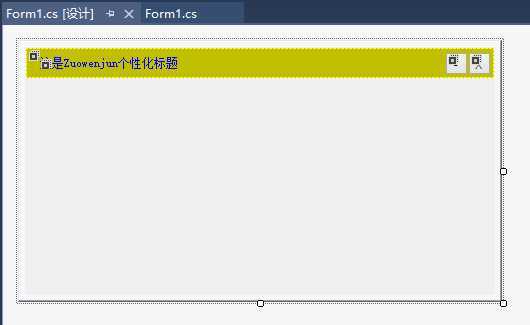
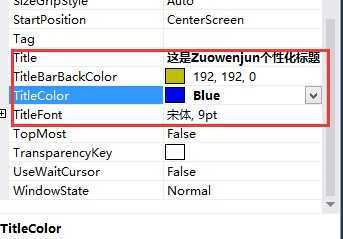
将MaximizeBox设为False时,运行的效果,是不是有点爽啊!
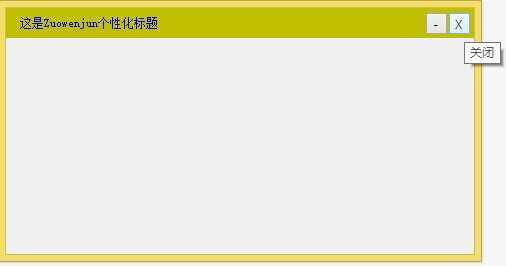
好了,都说完了,其实也很简单,我相信大部份高手都是不屑一看的,但此处只是作为一个学习与参考,可能大家有更好的方法,欢迎大家交流,共同进步。
最后我上传源码,仅大家参考与改进:
——
标签:des winform style blog http io ar color os
原文地址:http://www.cnblogs.com/zuowj/p/4133574.html